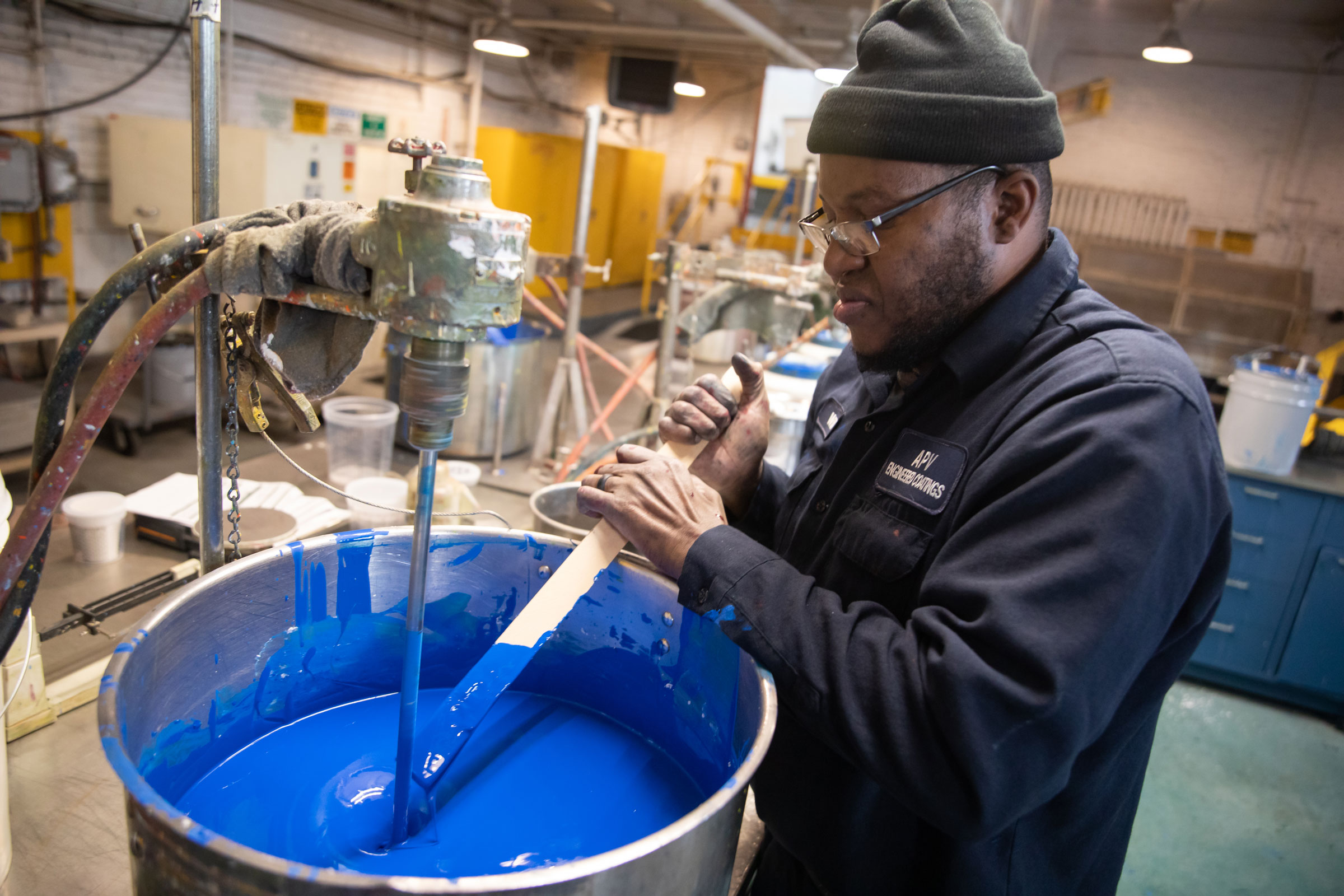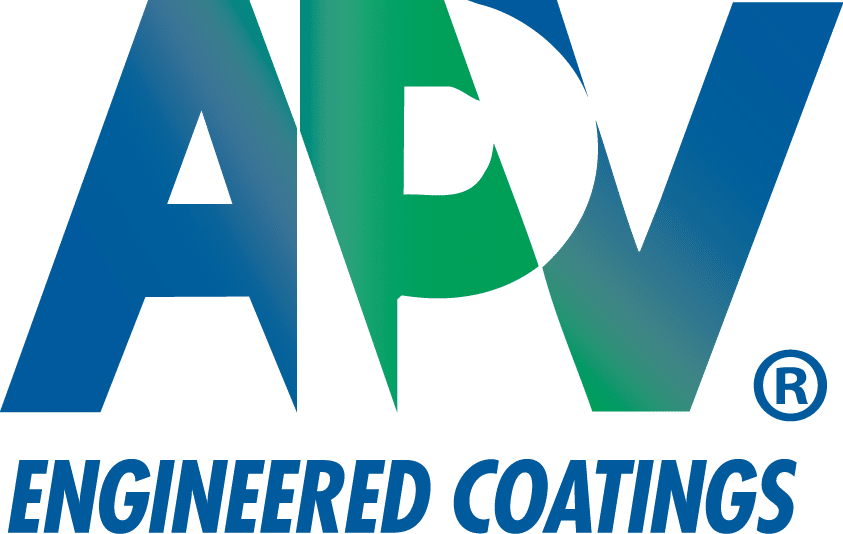In an effort to reduce operating costs, shrink power plant–generated greenhouse gas emissions, obtain green building certifications, and make building materials last longer, owners and managers of commercial buildings are looking for ways to lower their building’s energy consumption. Among the many energy-savings strategies they may consider, use of cool walls is starting to gain traction.
Cool walls, like cool roofs, are designed to reflect solar radiation and emit heat more efficiently, to reduce heat build-up (HBU) on the substrate and inside the building, as well as potentially reduce air conditioning loads. Like cool roofs, cool walls can be achieved either by installing solar-reflective materials during initial construction or by refinishing an existing facade with a solar-reflective coating, making cool walls a winning strategy for new-build and renovation projects alike.
Energy Use in Commercial Buildings
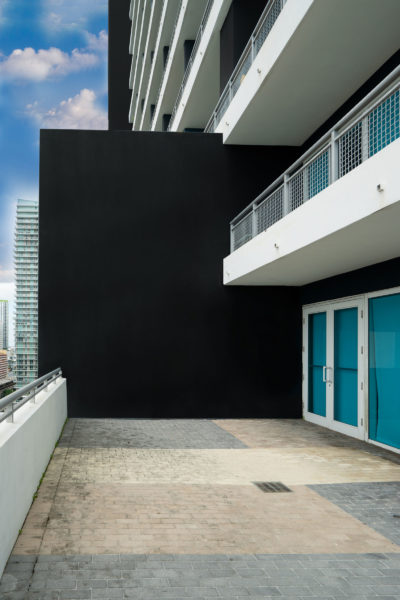
A black facade in Miami. Photo courtesy of APV Engineered Coatings
On average, commercial buildings account for 18% of the country’s primary energy use and 35% of its electricity consumption; and the EPA estimates 30% of that energy goes to waste. Because cooling systems consume 15% of the electricity used by commercial buildings, property owners can recognize significant savings by reducing the energy required to run them.
Improved energy efficiency does more than help commercial buildings save on operating costs. It can also help them achieve credits toward green building programs such as the USGBC’s LEED program, the Green Building Initiative’s Green Globes program, and the International Living Future Institute’s Living Building Challenge. Certifications in these programs provide building owners with a valuable point of differentiation to help them attract and retain tenants.
Improved energy efficiency also helps commercial buildings reduce their contribution to urban heat islands (UHIs), further improving their environmental footprint. UHIs form when trees and other vegetation are replaced with buildings, roads, and other heat-absorbing infrastructures that emit heat and make the outside air warmer. According to the Lawrence Berkeley National Laboratory, UHIs can increase air conditioning energy use, impair air quality by accelerating the formation of smog, and aggravate heat-related and respiratory illnesses.
The Science of Cool
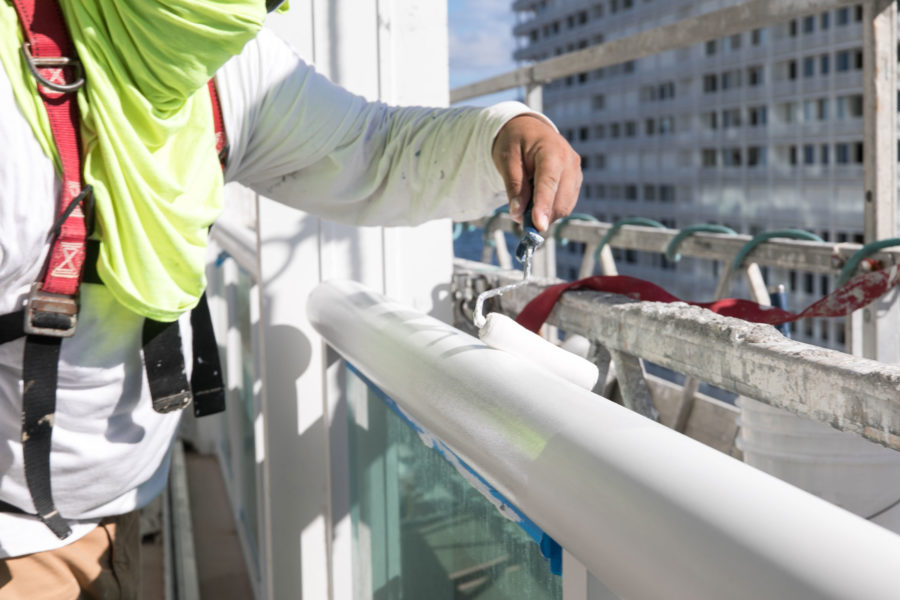
Roll application on railings with NeverFade coatings. Photo courtesy of APV Engineered Coatings
For more than two decades commercial buildings have been implementing cool roof technology to reduce energy consumption, improve occupant comfort, reduce maintenance costs and prolong the roof’s service life. Just as wearing light-colored clothing can help keep a person cool on a sunny day, cool roofs use solar-reflective surfaces to maintain lower roof temperatures. While traditional dark roofs can reach temperatures of 150F or more in the summer sun, a cool roof under the same conditions could stay more than 50F cooler, according to data from the US Department of Energy.
Three material surface properties can be measured to determine how cool or hot a roof is. Better performance in these areas can help to reduce a building’s HBU.
Total solar reflectance (TSR) is the fraction of sunlight that a surface reflects. Sunlight that is not reflected is absorbed as heat. Solar reflectance is measured on a scale of 0 to 1. A surface that reflects 55% of sunlight has a solar reflectance of 0.55. Most dark roof materials reflect 5 to 20% of incoming sunlight, while light-colored materials typically reflect 55 to 90%.
Light reflectance value (LRV) is similar and is typically applied to paints and coatings. It is defined as the total quantity of visible and usable light reflected by a surface in all directions and at all wavelengths when illuminated by a light source. LRV runs on a scale from 0 to 100%. The average blackest black surface has an LRV of approximately 5% while the whitest white has an LRV of about 85%.
Thermal emittance describes how efficiently a surface cools itself by emitting thermal radiation. It is measured on a scale of 0 to 1, where a value of 1 indicates a perfectly efficient emitter. Nearly all nonmetallic surfaces have high thermal emittance, usually between 0.80 and 0.95.
A roof surface’s Solar Reflectance Index (SRI) is another metric for measuring coolness. It is calculated from the solar reflectance and thermal emittance values. The higher the SRI, the cooler the roof will be in the sun. For example, a clean black roof could have an SRI of 0 while a clean white roof could have an SRI of 100. Dark roofs usually have an SRI less than 20.
From Roofs to Facades
The science behind cool roofs also can be applied to exterior building wall materials like siding, decking, cladding, and trim. Although exterior walls only receive about half as much sunlight as roofs, a building can have substantially more wall area than roof area, aggravating heat buildup. Several rating and certification organizations are supporting the cool wall trend with new programs.
The Cool Roof Rating Council (CRRC) recently expanded its scope and mission to include the rating of exterior wall products in addition to roofing. Beginning in January 2022 the CRRC will offer product ratings for companies interested in having their exterior wall products listed and labeled with information about the product’s surface radiative performance (solar reflectance and thermal emittance). The ratings will enable specifiers to identify products that comply with various codes and programs that require or promote the use of solar-reflective walls for reducing building energy use and/or mitigating the impacts of urban heat island effects.
Another organization promoting the use of cool walls is the USGBC, whose LEED program is piloting an initiative under its Heat Island Reduction Sustainable Sites Credits for the Building Design and Construction rating system. Under the program, buildings can obtain one credit for facing at least 75% of their gross exterior wall area with cool-wall materials, which are defined as opaque to sunlight, offering an initial solar reflectance of at least 0.60, and exhibiting an initial thermal emittance of at least 0.75.
In addition, ASHRAE recently published an addendum to its 90.1 energy standard for buildings (except low-rise residential buildings) that credits cool-wall energy savings in performance compliance for the standard.
The Cooling Effect of Coatings
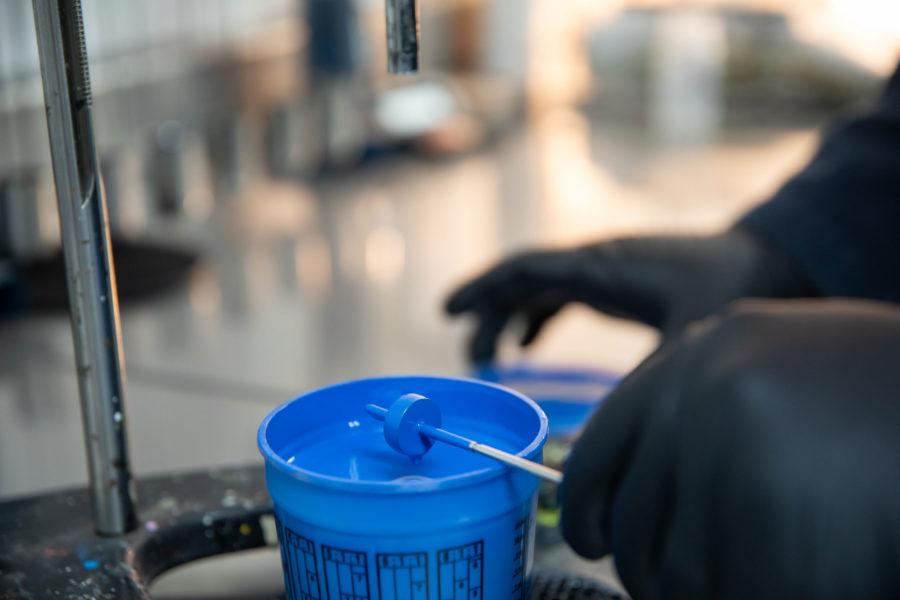
Photo courtesy of APV Engineered Coatings
Short of physical shading, the best way to achieve a cool roof or facade is by coating it. Coatings—whether applied in the factory by the building product OEM or applied in the field by a professional coating contractor—are especially recommended for composite building materials because they are heat-sensitive and tend to break down more easily and rapidly under solar exposure than natural building materials like wood.
However, not all coatings provide the performance needed to achieve high TSR, LRV, and thermal emittance. For example, exterior latex and premium acrylic binders in paints will break down when exposed to solar irradiance—allowing dirt, mold, and mildew to infiltrate the coated surface, which reduces TSR and related energy savings. This breakdown is called film erosion, where the coating chalks and wears away from the substrate and will continue to do so until the coating no longer protects the surface.
Coating systems formulated with polyvinylidene fluoride (PVDF) resin, on the other hand, resist photochemical degradation to deliver better long-term protection. PVDF’s incredibly strong carbon-fluorine bonds stand up to film erosion, even under exposure to the elements, allowing its protective properties—including TSR, dirt shedding, algae and mold resistance, color retention, and chalking resistance—to last significantly longer. Dirt shedding and algae/mold resistance properties are particularly important as dirty surfaces reduce solar reflectance.
A coating’s pigments also play a crucial role in its TSR, LRV, and thermal emittance properties. For example, organic pigments, like the binder discussed previously, also break down over time when exposed to UV energy and the elements. Complex inorganic pigments, on the other hand, contain mixed metal oxides that reflect the sun’s rays. In comparison to organic pigments, complex inorganics—especially IR-reflective types—and when used in a PVDF-based formulation, are encapsulated by the fluoropolymer for additional protection from the elemental exposure that can break them down and therefore maintaining their color for much longer.
Even Black Can Be Cool
While lighter colors reflect more of the sun’s rays and are less prone to heat buildup than darker colors, coatings do not always have to be bright white to provide desired cooling effects. Such cool dark colors reflect more sunlight than the same color in a conventional binder.
Black is a trending color in architecture, and more building owners are turning to black to create visual impact in everything from window trim to siding. Replacing a standard warm color with a matching cool color can boost solar reflectance by as much as 0.4 without affecting appearance, according to experts at the Berkeley Lab.
Recent tests of cool dark-colored coatings have shown that, when the right IR-reflective pigments are used in a PVDF-based coating formula, even the color black can offer lower TSR, LRV, and thermal emittance properties desired by architects and building owners.
The table below shows the TSR, LRV, and HBU of several commercially available coatings when used on a PVC-based composite siding trim board. The study was conducted for a PVC siding manufacturer after receiving complaints that their black siding material warped under UV-prone environments.
In this study, there were three control specimens:
1. APV’s PVDF-based topcoat with standard non-metallic inorganic white pigment
2. A PVC-based composite siding manufacturer’s trim board that was factory coated with a white coating
3. APV’s PVDF-based topcoat with standard non-metallic inorganic black pigment.
Five types of coatings were evaluated and compared to the control samples:
1. APV’s PVDF-based topcoat with all IR reflective black pigments
2. APV’s PVDF-based topcoat with 90% IR reflective inorganic pigments and 10% of a standard non-metallic inorganic black pigment
3. Three off-the-shelf, acrylic-based black coatings promoted as being weather-resistant.
After the test data was gathered, the PVDF-based coating with 100% IR reflective complex inorganic black pigments yielded the greatest cool performance compared to all other black test specimens with a 25.6% TSR and 28 HBU.
Comparatively, the average of the three off-the-shelf, acrylic-based black high-performance acrylic based coatings equated to 5.5% TSR and 41.9 HBU.
The APV PVDF-based topcoat with standard non-metallic inorganic black pigment had a 4.5% TSR and 41.9 HBU reading, which was in line with the three off-the-shelf acrylic-based premium black paints tested.
In summary, the PVDF coating with IR-reflective pigments had a 20.3% increase in TSR and a 32.6% decrease in heat buildup compared to the average of four black standard coatings.
It can also be noted that when incorporating 10% of a standard black pigment with an IR reflective type, it dramatically reduced its reflectivity and heat gain values.
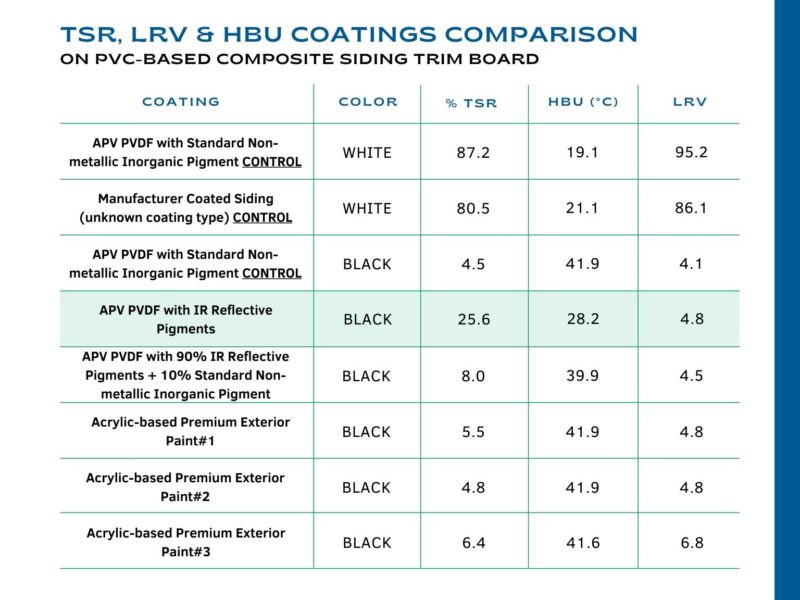
Image courtesy of APV Engineered Coatings
Keeping Your Cool
The sun’s heat is one of the biggest contributors to reduced durability and longevity of building systems and components like roofs, siding, and trim. The right protective coating—one that is formulated with PVDF resin and complex inorganic IR-reflective pigments—can help reduce film erosion and heat absorption by reflecting UV and infrared radiation.
Such high-performance coatings can also resist buildup of dirt, mold, and mildew, keeping them cleaner, reducing the amount of maintenance needed, and allowing the reflective properties to be sustained for longer.
With the recent trend toward dark facade components, selecting the proper coating is more important than ever and can help building product OEMs, architectural renovation specifiers, and property owners alike get more life out of their facade materials while helping buildings reduce their energy use and become more environmentally sustainable.

